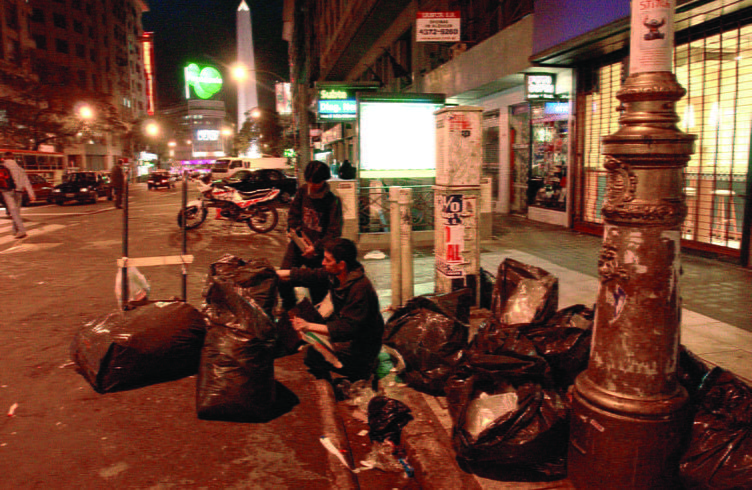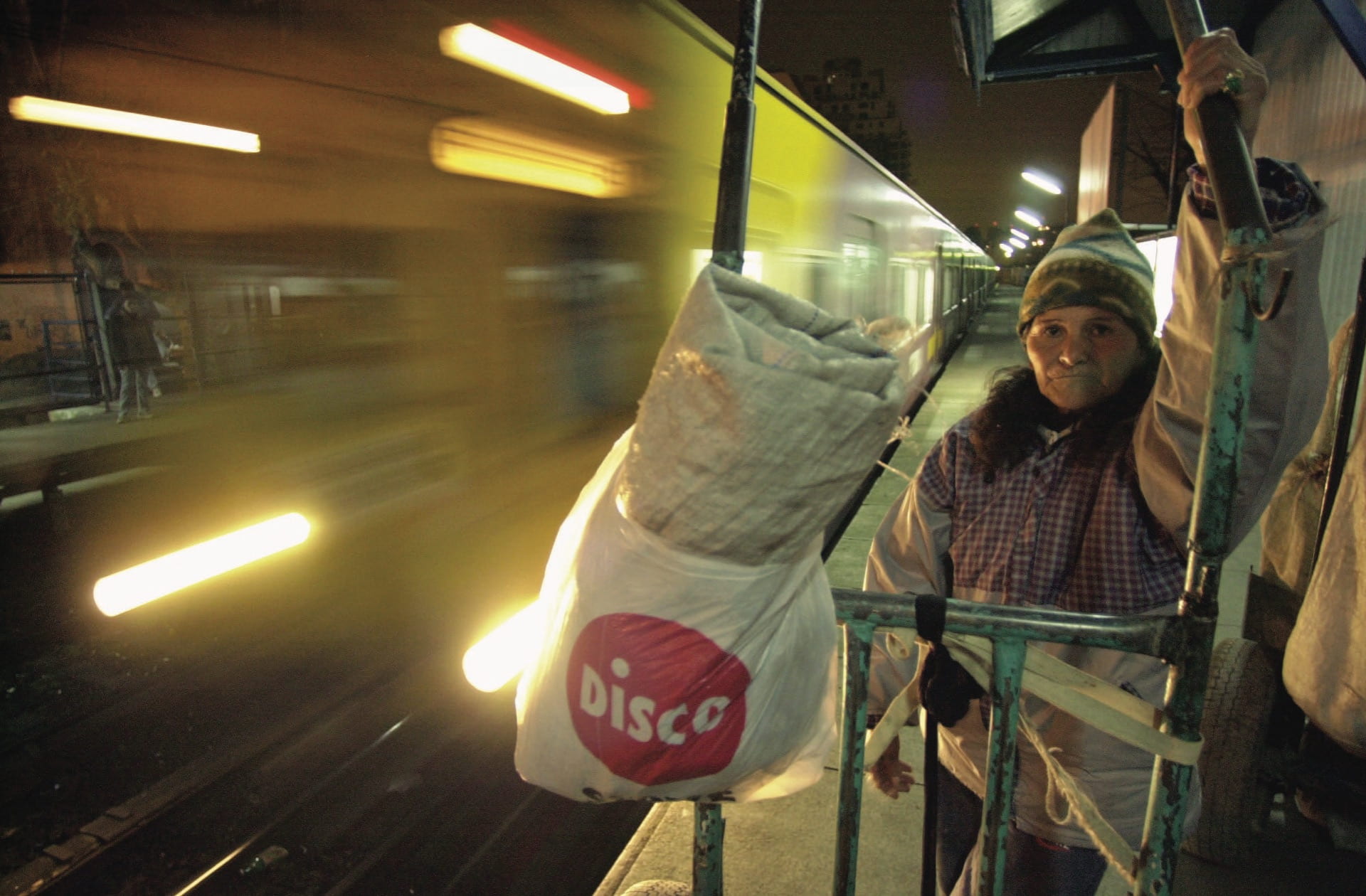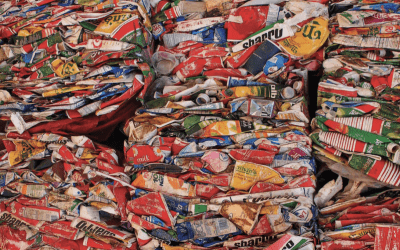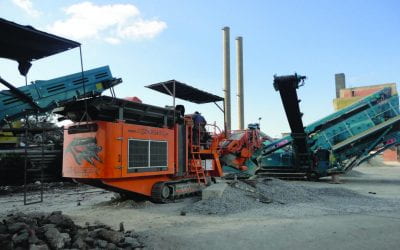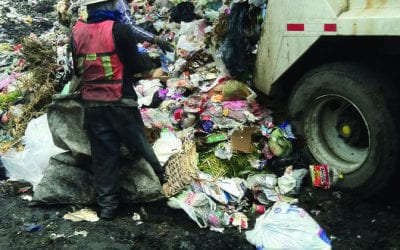Thinking on Film and Trash
A Few Notes
Journalist: How do you see the
future of scrap?
Melzig: I don’t see it, I experience it.
Journalist: The future has
already begun?
Melzig: It never stopped beginning.
From “The Blind Director” a 1985 film by
Alexander Kluge
Latin American films have portrayed trash as an urban social issue since the 1940s, if not earlier. If the first incentive to film trash and its presence in the city was hygiene, very soon after that decade filmmakers began to depict the process of collecting trash as an activity that carries an important economic and social impact. In very early newsreels one could find some of the same informal recyclers that we can still see today, but in those images the rag picker is a lonely character walking or riding a carriage through the city far from the collective activity of today’s informal recycling. The number of documentaries today related to trash is vast and therefore this very short list of films is one of many possible ones.
Leaving aside the newsreels that were for the most part screened at film theaters before the main feature, a brief history of films and trash could also be thought of as a history of the changes that took place in the making of Latin American documentaries. By the 1950s a film like Tire Dié (Fernando Birri, Argentina, 1956) already portrays the collecting, classifying and recycling of trash not only as a source of informal income but as a commercial activity linked to the formal economy. In the film trash is included as a component of a newly formed shantytown, which in turn depends on the city and the train that connects Santa Fe and Buenos Aires. Birri’s film showcases the multiple efforts of the shantytowns population to overcome extreme poverty, but Doña Lola, the person who runs the local landfill within the shantytown, is the only example of true economic success offered in the film. Her story underlies the importance of trash as an economic factor:
I’m known around here as Doña Lola. I’ve been here for 15 years and I am happy because I’ve prospered. I started out very poor but now I’m as well off as anybody else. I have many different types of animals. I also have hotels, boarding houses, all over. There is ‘Los Hornos’ … which is a North American property and a lot of trash comes out of there. Mostly paper which is what we also gather. Paper, glass, bones and all that. Everything is done along with my children and laborer. I own three carts.
Birri’s films of this period stressed the hard working qualities of the inhabitants of the poverty belt. They are arguably the beginning of the long lasting influence of Italian Neorealism on Latin American documentary filmmaking. Tire Dié manages to strike a balance between a concern for the people of the shantytown and the attention to economic and social factors and became the poster child of social documentary making for several generations to come.
Shortly after Birri, Alberto Miller directs Cantegriles (Alberto Miller, Uruguay, 1958) a short visual masterpiece with piano music as the only sound track that focuses on the life on and around a landfill. Its attention to the interaction between people and trash is a good precedent for a new upcoming transformation of the genre: Quema (Alberto Fisherman, Argentina, 1962). As a film Quema is not only daring because of its formal choices—voice over and reenactment—but because of its capacity to stylize the extreme poverty of the everyday life of the landfill. All this is possible thanks to the camera work of Ch. Tinkelenberg and the sound track of A. Bratslavsky. The emphasis on the aesthetic anticipates the connection between art and trash that would become the signature of Antonio Berni, one of the most relevant artists of the same period. Berni would create murals made out as collages of found material, in some cases taken from the very same area in which Quema was filmed.
The absurd as the logical cinematographic response to the irrational waste of a consumer society makes a stellar entrance in the history of Latin American of film on trash with Ilha das flores (Jorge Furtado, Brazil, 1989). Furtado’s is also one of the first films to center its focus on tracing the transformations of trash from the harvesting of a tomato to the people that will search a dump in search for edible food. Until then the emphasis of most of these films was on social conditions and the people who deal with trash. Ihla das Flores creates a narrative where every human character in the movie is subservient to the object, the tomato of the story. Furtado uses techniques that resemble Monty Python animations of still images and it does so as an effective strategy to link the very detailed story of one tomato to larger political issues such a race, religion and ultimate to global politics.
Boca do lixo (Eduardo Coutinho, Brazil, 1993) avoids the voice over and centers on the people of the landfill but with a twist. While films like Tire Dié stress the pathos of each of the testimonies in function of a larger narrative, Boca do lixomakes each interview a stand-alone story. As a result Coutinho avoids melodrama and the neorrealist effect and allows the spectator to see the different stories as a narrative composite. It is not only a matter of keeping sentimentality at bay; what really matters in Boca do lixo are the multiple narratives. By now it is becoming more evident that every new film on trash will pick and choose a particular aesthetic and increasingly give up the pretension of transparency. That was in fact my own experience during the making of Cartoneros (Argentina, 2006). The illusion of “just” collecting testimonies was not a possibility anymore; the challenge became to link every element of the film as much as possible to its main narrative while becoming increasingly aware of the formal choices one makes at the moment of portraying trash.
All these films share an awareness that the trash is not the end of a process of consumption but the beginning of a cycle of production. In a sense these movies anticipate, rehearse and expose the notion of recycling as an integral part of different economic models. Today, knowing how many of the issues put forward by these Latin American films are shared beyond national boundaries helps to create a global picture of the issues at stake. Trash, garbage, scrap, rags and bones, cirujas, cartoneros, catadores, pepenadores, etc. are a fundamental part of an informal economy that shares problems and solutions independently of national borders. The particulars of local situations might differ from one location to the other but they share a substantial number of issues. What movies on trash have shown is their capacity of pointing simultaneously to the particular and the general in the same film.
These movies share the idea that trash could be a departure point to think about the modern condition as defined by consumption, class disparities, contamination and urban development. The poet Charles Baudelaire is one of the first to make the connection between the rag picker and the modern city. Walter Benjamin picks it up and from then on the fragmentary condition of trash will remain associated with contemporary art and ultimately with the Modern condition: the industrial refuse could be redeemed by art. It is in this sense that filmmaking becomes allegorical and mimics the process of recycling when it reappropiates archival materials and found footage to create new narratives from scraps, fragments, of films that were not in any way connected to these new narratives.
As the opening quote in this article indicates, the future history of films and trash has already begun. Above everything else, these movies are part of an expansive process in which trash is becoming a globalized topic and film makes more visible what in many cases has been invisible or ignored. Their focus on trash expose unjust social conditions and also show the transformative process of an integral part of a truly globalized economy. By doing so, they have the potential of telling the story of Latin America’s environmental crisis and its place in a global reality.
Winter 2015, Volume XIV, Number 2
Ernesto Livon-Grosman is an Associate Professor of Hispanic Studies at Boston College. His film Cartoneros was awarded several distinctions, including best educational film at the 2007 Tulipanes International Film Festival.
Related Articles
Garbage: Editor’s Letter
Religion is a topic that’s been on my ReVista theme list for a very long time. It’s constantly made its way into other issues from Fiestas to Memory and Democracy to Natural Disasters. Religion permeates Latin America…
Buenos Aires, Wasteland
English + Español
Walking down Avenida Juan de Garay last week, I passed a giant black trash bag that had ballooned and burst. Orange peels, tomatoes, candy wrappers…
First Take: Waste
Waste—its generation, collection and disposal—is a major global challenge in the 21st century. Cities are responsible for managing municipal waste. Solid…

